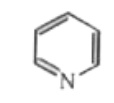Amongst the following, the most basic compound is-
C6H5NH2
p−NO2−C6H4NH2
m−NO2−C6H4NH2
C6H5CH2NH2.
The correct Answer is:D
To determine the most basic compound among the given options, we need to analyze the basicity of each compound based on the presence of electron-donating or electron-withdrawing groups and the involvement of lone pairs in resonance. Here’s a step-by-step solution:
Step 1: Identify the Compounds
Let's assume the compounds are:
1. Aniline
2. Meta-nitroaniline
3. Para-nitroaniline
4. Benzylamine
Step 2: Understand Basicity in Amines
Amines are basic because they have a lone pair of electrons on the nitrogen atom that can be donated to protons (H⁺). The basicity of amines can be affected by substituents on the aromatic ring:
- Electron-donating groups (like alkyl groups) increase basicity.
- Electron-withdrawing groups (like nitro groups) decrease basicity.
Step 3: Analyze Each Compound
1. Aniline: The lone pair on nitrogen is partially involved in resonance with the aromatic ring, which reduces its availability to bond with protons. Thus, it has moderate basicity.
2. Meta-nitroaniline: The nitro group (NO₂) is an electron-withdrawing group. At the meta position, it primarily exerts a -I (inductive) effect, which decreases basicity but not as strongly as at the para position.
3. Para-nitroaniline: The nitro group at the para position exerts both -I and -M (mesomeric) effects, significantly reducing the basicity due to resonance involvement of the lone pair.
4. Benzylamine: This is a primary amine where the lone pair on nitrogen is not involved in resonance with any aromatic system. Therefore, it remains available for protonation, making it the most basic among the options.
Step 4: Conclusion
Based on the analysis:
- Benzylamine is the most basic compound because its lone pair is not involved in resonance, allowing it to readily accept protons.
Therefore, the answer is Benzylamine.
Let's assume the compounds are:
1. Aniline
2. Meta-nitroaniline
3. Para-nitroaniline
4. Benzylamine
Amines are basic because they have a lone pair of electrons on the nitrogen atom that can be donated to protons (H⁺). The basicity of amines can be affected by substituents on the aromatic ring:
- Electron-donating groups (like alkyl groups) increase basicity.
- Electron-withdrawing groups (like nitro groups) decrease basicity.
1. Aniline: The lone pair on nitrogen is partially involved in resonance with the aromatic ring, which reduces its availability to bond with protons. Thus, it has moderate basicity.
2. Meta-nitroaniline: The nitro group (NO₂) is an electron-withdrawing group. At the meta position, it primarily exerts a -I (inductive) effect, which decreases basicity but not as strongly as at the para position.
Based on the analysis:
- Benzylamine is the most basic compound because its lone pair is not involved in resonance, allowing it to readily accept protons.
Topper's Solved these Questions
Similar Questions
Knowledge Check
Among the following compounds, the most basic compound is :
A B
B C
C D
D
Amongst the following, the number of compounds soluble in aqueous NaOH is
?
 ,
, 
View SolutionAmongst the following, the amongst base in aquesous medium is….
View SolutionSelect the most basic compound.
View SolutionSelect the most basic compound.
View SolutionWhich of the following is most basic
View Solution
Amongst the following, total no of aromatic compounds are
View SolutionWhich of the following is most basic ?
View Solution
